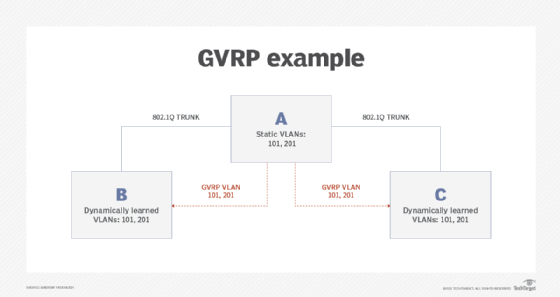GVRP (GARP VLAN Registration Protocol or Generic VLAN Registration Protocol)
What is GVRP (GARP VLAN Registration Protocol or Generic VLAN Registration Protocol)?
GVRP (GARP VLAN Registration Protocol or Generic VLAN Registration Protocol) is a standards-based protocol that facilitates control of virtual local area networks (VLANs) within a larger network. GVRP conforms to the Institute of Electrical and Electronics Engineers (IEEE) 802.1Q specification, which defines a method of tagging frames with VLAN configuration data over network trunk interconnects. This enables network devices to dynamically exchange VLAN configuration information with other devices.
GVRP is based on Generic Attribute Registration Protocol (GARP) and IEEE 802.1r, which defines procedures for end stations and switches in a VLAN to register and deregister attributes, such as identifiers or addresses, with each other. It provides every end station and switch with a current record of all the other end stations and switches that can be reached on the network. GVRP is similar to GARP, as both eliminate unnecessary network traffic by preventing attempts to transmit information to unregistered users. In addition, it is necessary to manually configure only one switch with all the other switches then being updated automatically.
Becoming part of a formal IEEE 802.1ak standard amendment in 2007, Multiple VLAN Registration Protocol replaced GVRP, as it was found to be prone to performance issues that could potentially cause prolonged network convergence. This delay was found to create bandwidth degradation on the network at the point where the delayed convergence appeared. Technically, GVRP is still included as part of the IEEE standard, as the amendment did not completely remove it. It is expected to be removed in the future, but until that happens, GVRP is still being used.
Why use GVRP?
On large networks that consist of dozens or even hundreds of VLAN segments, GVRP can be used to keep VLAN configurations on trunk interfaces organized across the network. There are three benefits for administrators that enable GVRP on a network:
- It enables switches to automatically delete unused VLANs so that only the VLANs that are in use are transported across 802.1Q trunk links.
- It enables admins to configure a new VLAN on one switch and then have it propagate the configuration across all network switches participating in the GVRP process.
- GVRP can eliminate some unnecessary broadcast traffic on the network, reducing bandwidth overhead used for network management.
How does GVRP work?
Two or more switches in a network that are connected via 802.1Q trunk ports with GVRP enabled will begin communicating both statically and dynamically with VLAN information. Switches with statically configured VLANs will advertise them to connected switches using GVRP data units. Those units are specifically designed management packets used to share VLAN information. If a switch learns of a new VLAN from its neighbor, this VLAN is added to the list of VLAN tags that can be transported across the link. The VLAN that learned the new information can then pass along its own statically configured VLANs, in addition to ones learned from its neighbor. The caveat is that the switch cannot send dynamically learned VLAN information out the same interface that it was learned on. This is a loop avoidance technique.
All the dynamically learned VLAN information is stored in switch memory. So, if power is lost or the switch is rebooted, the dynamically learned VLAN info is lost, and the VLANs are pruned from the trunk interface. But, once the switches begin communicating again, they will relearn the shared VLAN information to bring the network and all VLANs back into a fully informed state.
How do I enable GVRP?
While the exact processes and syntax for enabling GVRP on a compatible switch vary from one vendor and switch model to the next, there are some similarities when it comes to enabling the use of GVRP:
- GVRP can be enabled or disabled globally on the switch.
- If GVRP is enabled, each individual switch port that is set up as an 802.1Q trunk can then be set to one of the following modes:
- GVRP-enabled. This mode enables GVRP on the trunk interface and passes both static and dynamically learned VLAN information to connected switches that are also in an enabled mode.
- GVRP-disabled. This mode disables the use of GVRP on the port, and a switch ignores any GVRP communications from connected switches on this interface.
- Block GVRP registration. This mode will unlearn or discard all previously learned dynamic VLANs and prevent VLAN creation or VLAN registration on the trunk port.
What is an example of GVRP?
The following example shows that distribution switch A is connected to two access switches labeled B and C. The access switches are connected to the distribution switch by an 802.1Q trunk with GVRP enabled globally and on the trunk interface.

For example, say that an admin logs in to switch A and statically configures VLAN 101 and 201. Once these VLANs are properly configured, GVRP packets are sent to switches B and C containing information about the new VLANs. These two access switches then add VLAN 101 and 201 to their table of statically and dynamically learned VLANs, placing both in the dynamically learned section.
Learn which seven network maintenance tasks are essential to ensure network security, connectivity and recoverability in the event of a disaster.







